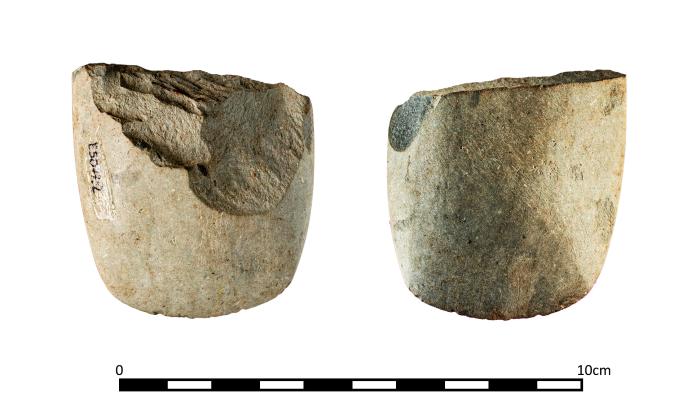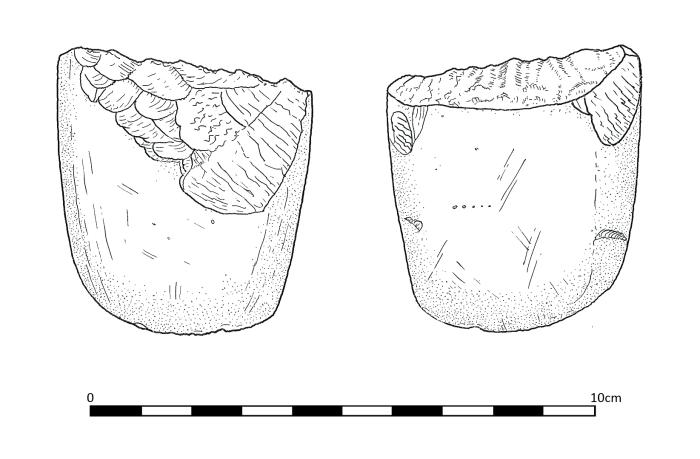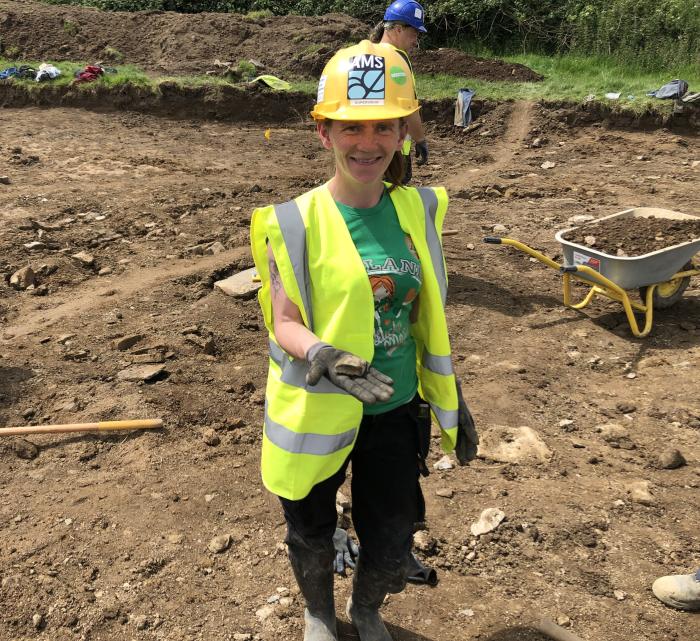A Great Langdale tuff axe from Shankill, Co. Roscommon
by senior archaeologist Ros Ó Maoldúin of Archaeological Management Solutions and geologist Stephen Mandal of The Irish Heritage School
Excavations in advance of the N5 Ballaghaderreen to Scramoge Road Scheme in County Roscommon led to the discovery of over 100 previously unrecorded archaeological sites revealing evidence of human activity in the area extending from the Mesolithic to modern times. Here we highlight a Neolithic axe with an exotic origin, found in Shankill townland, just east of Elphin town.

The Shankill Langdale tuff axe (Photo: John Channing, AMS).
The Shankill axe (artefact no. E5077:1) is one of seven stone axes found on the N5 project but is the only one made of a material with an origin traceable to outside of Ireland. It is made from a fine-grained green banded volcanic tuff, most likely belonging to the British Implement Petrology Committee Group VI, the most numerous and perhaps best-known stone axe types in Britain. Group VI is known to originate from sources in the Great Langdale and Scafell areas of Cumbria in north-western England. It was likely quarried from the top of Pike o’ Stickle or another deliberately difficult place to reach. Easily accessible high-quality outcrops were often left unexploited in favour of these difficult to reach locations. This, and the colour of these green stone axes, resonates with origin and procurement practices of jadeitite axes quarried in the Mount Bego region in the French Italian Alps thousands of years earlier, and brought to Britain and Ireland by the earliest Neolithic communities.

Illustration of the Shankill axe (Drawing: John Murphy).
The Shankill axe would have been roughed out close to the quarry and later ground and polished (using sandstone grinding-slabs and fine-grained sand) in a lowland settlement area. There are over 1,600 Langdale tuff axes from Britain and Ireland, making the Langdale tuff axe the most numerous axe type from the region; however, this still only represents a production average of between two and seven a year for the 250–750 years which the quarry sites are thought to have operated. In 1998, the Irish Stone Axe Project recorded just over 120 Langdale tuff axes from Ireland. The findspots are widely distributed, with notable concentrations in north County Antrim and around Lough Gur in County Limerick, but this is the first such axe from County Roscommon. The Shankill axe must have reached Roscommon either through ‘down-the-line’ exchange or in the hands of a traveller, either way indicating connections between communities across Britain and Ireland.
The blade of the axe is symmetrical and gently curved in plan. The axe is symmetrical in profile and very gently curved in section and there are clear junctions with both sides. Its left side is facetted, its right side is rounded, and, as stated above, morphologically it is classifiable as a Group VI axe. Its broken edge is covered by numerous flake scars suggesting that it was purposefully broken prior to deposition. Only the lower portion of the axe (that with the cutting edge) was present and it was found in a bedrock cleft where it had apparently been carefully placed. This is a well-attested practice with special resonance in Cumbria where, at locations like Stainton Quarry, axes were often deliberately broken and deposited in selected natural hollows and crevices.
Shankill 1 (the site on which the axe was found) was a multi-period site on which most of the remains were medieval, but there were other Neolithic stone finds and two radiocarbon dates from the site returned Early to Middle Neolithic dates (4000–3000 BC). The axe was found by one of our site supervisors, Renata Nolan, the first person to touch or hold it in about five and a half thousand years.

Supervisor Renata Nolan holding the Shankill Langdale tuff axe (Photo: Ros Ó Maoldúin, AMS)
During the early Neolithic, the Shankill axe was quarried from high on a mountain in Cumbria and then brought, possibly through a series of exchanges, to Roscommon. Its colour and the practices involved in its procurement echo practices from over 1,000 years earlier in the French/Italian Alps. Its travels to Roscommon provide tangible evidence of connections between Neolithic communities there and in Britain and Ireland. Its deliberate breaking and careful deposition suggest ritual imbued with meaning of which we can only make educated guesses. The other half of the axe may have been kept or placed elsewhere, creating a connection with the place and/or communities at Shankill.
A book detailing all of the finds from the N5 Ballaghaderreen to Scramoge Road Scheme is forthcoming, but readers can learn more from the StoryMap Through Bog & Meadow.
Further reading
Bradley, R & Edmonds, M 1993 Interpreting the Axe Trade. Cambridge University Press, Cambridge.
Cooney, G & Mandal, S 1998 The Irish Stone Axe Project. Wordwell, Dublin.
Cummins, W A & Clough, T H McK (eds) 1988 Stone Axe Studies, volume 2: the petrology of prehistoric stone implements from the British Isles. CBA Research Report 67. Council for British Archaeology, London.
Topping, P 2021 Neolithic Stone Extraction in Britain and Europe: an ethnoarchaeological perspective. Oxbow Books, Oxford.
(Posted 21 September 2023)